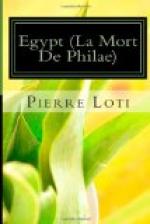To-night the succession of these rooms, filled with glass cases, which cover more than four hundred yards along the four sides of the building, seems to be without end. After passing, in turn, the papyri, the enamels, the vases that contain human entrails, we reach the mummies of the sacred beasts: cats, ibises, dogs, hawks, all with their mummy cloths and sarcophagi; and monkeys, too, that remain grotesque even in death. Then commence the human masks, and, upright in glass-fronted cupboards, the mummy cases in which the body, swathed in its mummy cloths, was moulded, and which reproduced, more or less enlarged, the figure of the deceased. Quite a lot of courtesans of the Greco-Roman epoch, moulded in paste in this wise after death and crowned with roses, smile at us provokingly from behind their windows. Masks of the colour of dead flesh alternate with others of gold which gleam as the light of our lantern plays upon them momentarily in our rapid passage. Their eyes are always too large, the eyelids too wide open and the dilated pupils seem to stare at us with alarm. Amongst these mummy cases and these coffin lids fashioned in the shape of the human figure, there are some that seem to have been made for giants; the head especially, beneath its cumbrous head-dress, the head stuffed as it were between the hunchback shoulders, looks enormous, out of all proportion to the body which, towards the feet, narrows like a scabbard.
Although our little lantern maintains its light we seem to see here less and less: the darkness around us in these vast rooms becomes almost overpowering—and these are the rooms, too, that, leading one into the other, facilitate the midnight promenade of those dread “forms” which, every evening, are released and roam about. . . .
On a table in the middle of one of these rooms a thing to make you shudder gleams in a glass box, a fragile thing that failed of life some two thousand years ago. It is the mummy of a human embryo, and someone, to appease the malice of this born-dead thing, had covered its face with a coating of gold—for, according to the belief of the Egyptians, these little abortions became the evil genii of their families if proper honour was not paid to them. At the end of its negligible body, the gilded head, with its great foetus eyes, is unforgettable for its suffering ugliness, for its frustrated and ferocious expression.
In the halls into which we next penetrate there are veritable dead bodies ranged on either side of us as we pass; their coffins are displayed in tiers one above the other; the air is heavy with the sickly odour of mummies; and on the ground, curled always like some huge serpent, the leather hoses are in readiness, for here indeed is the danger spot for fire.
And the master of this strange house whispers to me: “This is the place. Look! There they are.”
In truth I recognise the place, having often come here in the daytime, like other people. In spite of the darkness, which commences at some ten paces from us—so small is the circle of light cast by our lantern—I can distinguish the double row of the great royal coffins, open without shame in their glass cases. And standing against the walls, upright, like so many sentinels, are the coffin lids, fashioned in the shape of the human figure.




